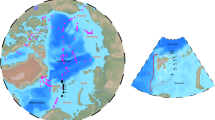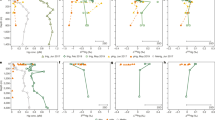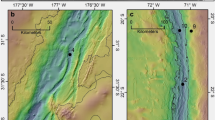Abstract
Mercury is a toxic, bioaccumulating trace metal whose emissions to the environment have increased significantly as a result of anthropogenic activities such as mining and fossil fuel combustion1,2. Several recent models have estimated that these emissions have increased the oceanic mercury inventory by 36–1,313 million moles since the 1500s2,3,4,5,6,7,8,9. Such predictions have remained largely untested owing to a lack of appropriate historical data and natural archives. Here we report oceanographic measurements of total dissolved mercury and related parameters from several recent expeditions to the Atlantic, Pacific, Southern and Arctic oceans. We find that deep North Atlantic waters and most intermediate waters are anomalously enriched in mercury relative to the deep waters of the South Atlantic, Southern and Pacific oceans, probably as a result of the incorporation of anthropogenic mercury. We estimate the total amount of anthropogenic mercury present in the global ocean to be 290 ± 80 million moles, with almost two-thirds residing in water shallower than a thousand metres. Our findings suggest that anthropogenic perturbations to the global mercury cycle have led to an approximately 150 per cent increase in the amount of mercury in thermocline waters and have tripled the mercury content of surface waters compared to pre-anthropogenic conditions. This information may aid our understanding of the processes and the depths at which inorganic mercury species are converted into toxic methyl mercury and subsequently bioaccumulated in marine food webs.
This is a preview of subscription content, access via your institution
Access options
Subscribe to this journal
Receive 51 print issues and online access
$199.00 per year
only $3.90 per issue
Buy this article
- Purchase on Springer Link
- Instant access to full article PDF
Prices may be subject to local taxes which are calculated during checkout


Similar content being viewed by others
References
Fitzgerald, W. F. & Lamborg, C. H. in Treatise on Geochemistry (eds Holland, H. D. & Turekian, K. K. ) Vol. 9, Ch. 4, 1–47 (Pergamon, 2003)
Streets, D. G. et al. All-time releases of mercury to the atmosphere from human activities. Environ. Sci. Technol. 45, 10485–10491 (2011)
Mason, R. P., Fitzgerald, W. F. & Morel, F. M. M. The biogeochemical cycling of elemental mercury—anthropogenic influences. Geochim. Cosmochim. Acta 58, 3191–3198 (1994)
Lamborg, C. H., Fitzgerald, W. F., O'Donnell, J. & Torgersen, T. A non-steady-state compartmental model of global-scale mercury biogeochemistry with interhemispheric atmospheric gradients. Geochim. Cosmochim. Acta 66, 1105–1118 (2002)
Selin, N. E. et al. Global 3-D land-ocean-atmosphere model for mercury: present-day versus preindustrial cycles and anthropogenic enrichment factors for deposition. Glob. Biogeochem. Cycles 22, GB2011 (2008)
Soerensen, A. L. et al. An improved global model for air-sea exchange of mercury: high concentrations over the North Atlantic. Environ. Sci. Technol. 44, 8574–8580 (2010)
Sunderland, E. M. & Mason, R. P. Human impacts on open ocean mercury concentrations. Glob. Biogeochem. Cycles 21, GB4022 (2007)
Strode, S., Jaegle, L. & Emerson, S. Vertical transport of anthropogenic mercury in the ocean. Glob. Biogeochem. Cycles 24, GB4014 (2010)
Amos, H. M., Jacob, D. J., Streets, D. G. & Sunderland, E. M. Legacy impacts of all-time anthropogenic emissions on the global mercury cycle. Glob. Biogeochem. Cycles 27, 410–421 (2013)
Volk, T. & Hoffert, M. in The Carbon Cycle and Atmospheric CO2: Natural Variations Archean to Present (eds Sundquist, E. & Broecker, W. S. ) 99–110 (American Geophysical Union, 1985)
Morel, F. M. M., Milligan, A. J. & Saito, M. A. in Treatise on Geochemistry Vol. 6 The Oceans and Marine Geochemistry (ed. Elderfield, H. ) 113–143 (Elsevier, 2003)
Anderson, L. A. & Sarmiento, J. L. Redfield ratios of remineralization determined by nutrient data-analysis. Glob. Biogeochem. Cycles 8, 65–80 (1994)
Bowman, K. L., Hammerschmidt, C. R., Lamborg, C. H. & Swarr, G. J. Mercury in the North Atlantic Ocean: the U.S. GEOTRACES zonal and meridional sections. Deep Sea Res. II (in the press)
Cossa, D. et al. Mercury in the Southern Ocean. Geochim. Cosmochim. Acta 75, 4037–4052 (2011)
Hammerschmidt, C. R. & Bowman, K. L. Vertical methylmercury distribution in the subtropical North Pacific. Mar. Chem. 132–133, 77–82 (2012)
Sunderland, E. M., Krabbenhoft, D. P., Moreau, J. W., Strode, S. A. & Landing, W. M. Mercury sources, distribution, and bioavailability in the North Pacific Ocean: insights from data and models. Glob. Biogeochem. Cycles 23, GB2010 (2009)
Gruber, N., Sarmiento, J. L. & Stocker, T. F. An improved method for detecting anthropogenic CO2 in the oceans. Glob. Biogeochem. Cycles 10, 809–837 (1996)
Sabine, C. L. et al. The oceanic sink for anthropogenic CO2 . Science 305, 367–371 (2004)
Key, R. M. et al. A global ocean carbon climatology: results from Global Data Analysis Project (GLODAP). Glob. Biogeochem. Cycles 18, GB4031 (2004)
Streets, D. G., Zhang, Q. & Wu, Y. Projections of global mercury emissions in 2050. Environ. Sci. Technol. 43, 2983–2988 (2009)
Pacyna, E. G. et al. Global emission of mercury to the atmosphere from anthropogenic sources in 2005 and projections to 2020. Atmos. Environ. 44, 2487–2499 (2010)
Le Quéré, C. et al. The global carbon budget 1959–2011. Earth Syst. Sci. Data Discuss. 5, 1107–1157 (2012)
Mason, R. P., Rolfhus, K. R. & Fitzgerald, W. F. Mercury in the North Atlantic. Mar. Chem. 61, 37–53 (1998)
Lamborg, C. H. et al. Modern and historic atmospheric mercury fluxes in both hemispheres: global and regional mercury cycling implications. Glob. Biogeochem. Cycles 16, 1104 (2002)
Mason, R. P. et al. Mercury biogeochemical cycling in the ocean and policy implications. Environ. Res. 119, 101–117 (2012)
Selin, N. E. Global change and mercury cycling: challenges for implementing a global mercury treaty. Environ. Toxicol. Chem. 33, 1202–1210 (2014)
Jaegle, L., Zhang, Y., Thompson, L., Emerson, S. & Trossman, D. The Past 600 Years: Changing Hg Concentrations in a Global 3D Ocean Tracer Model. In 11th Int. Conf. on Mercury as a Global Pollutant (Edinburgh, 2013); abstr. M4-1000, http://www.mercury2013.com/
Khatiwala, S. et al. Global ocean storage of anthropogenic carbon. Biogeosciences 10, 2169–2191 (2013)
Cutter, G. A. & . Bruland, K. W. Rapid and noncontaminating sampling system for trace elements in global ocean surveys. Limnol. Oceanogr. Meth. 10, 425–436 (2012)
Gill, G. A. & Fitzgerald, W. F. Picomolar mercury measurements in sea water and other materials using stannous chloride reduction and two-stage gold amalgamation with gas phase detection. Mar. Chem. 20, 227–243 (1987)
Fitzgerald, W. F. & Gill, G. A. Subnanogram determination of mercury by two-stage gold amalgamation applied to atmospheric analysis. Anal. Chem. 51, 1714–1720 (1979)
Lamborg, C. H. Hammerschmidt, C. R., Gill, G. A., Mason, R. P. & Gichuki, S. An intercomparison of procedures for the determination of total mercury in seawater and recommendations regarding mercury speciation during GEOTRACES cruises. Limnol. Oceanogr. Meth. 10, 90–100 (2012)
Weiss, R. F. Solubility of nitrogen, oxygen and argon in water and seawater. Deep-Sea Res. 17, 721–735 (1970)
Hammerschmidt, C. R. & Fitzgerald, W. F. Bioaccumulation and trophic transfer of methylmercury in Long Island Sound. Arch. Environ. Contam. Toxicol. 51, 416–424 (2006)
Eggimann, D. W. & Betzer, P. R. Decomposition and analysis of refractory oceanic suspended materials. Anal. Chem. 48, 886–890 (1976)
Lamborg, C. H. et al. The flux of bio- and lithogenic material associated with sinking particles in the mesopelagic "twilight zone" of the northwest and North Central Pacific Ocean. Deep-Sea Res. II 55, 1540–1563 (2008)
Talley, L. D. et al. North Pacific Intermediate Water in the Kuroshio Oyashio mixed water region. J. Phys. Oceanogr. 25, 475–501 (1995)
Acknowledgements
We thank the captains and crews of all cruises, as well as: P. Morton, J. Fitzsimmons, R. Shelley, A. Aguilar-Islas, R. Bundy, P. Morris, S. Owens, K. Wang, S. Rigaud and S. Pike for sample collection during the North Atlantic GEOTRACES cruise; L. Groot, D. Weiss, P. Laan, J. de Jong, R. Middag, L. Pena, A. Hartman, J. M. Godoy, L. Gerringa, M. Boyé and J. Dérot for sample collection during the South Atlantic GEOTRACES cruise; T. Goepfert, E. Bertrand and D. Moran for sampling during the Metalloenzyme cruise; and M. Rutgers van der Loeff and B. Galfond for providing samples from the 2011 Polarstern cruise ARK-XXVI/3–TransArc to the central Arctic Ocean. We are also grateful to D. Cossa and E. Sunderland for providing digital versions of their Southern Ocean and P16 data. We also thank H. Amos, L. Jaegle, B. Jonsson, R. Mason, E. Sunderland and Y. Zhang for discussions and D. Cossa for comments. This work was supported by NSF grant numbers OCE-0825108, OCE-0825157, OCE-0927274, OCE-0928191, OCE-1031271, OCE-1132480 and OCE-1132515. We thank co-Principal Investigators R. Mason and G. Gill. L.-E.H. thanks J. E Sonke for funding Arctic Ocean observations via research grant ERC-2010-StG_20091028 to JES.
Author information
Authors and Affiliations
Contributions
C.H.L., C.R.H., K.L.B., G.J.S., D.C.O., L.-E.H., M.J.A.R. and M.A.S. participated in the GEOTRACES, Metalloenzyme cruises. C.H.L., C.R.H., K.L.B., G.J.S. and L.-E.H. performed Hg analyses. D.C.O. and P.J.L. designed the particulate sampling experiments and performed P analyses. C.H.L., C.R.H., M.J.A.R., M.A.S. and L.-E.H. designed the Hg-related experiments. C.H.L., C.R.H., K.L.B., G.J.S., K.M.M. and L.-E.H. interpreted the data. All authors contributed to manuscript preparation.
Corresponding author
Supplementary information
Supplementary Information
This file contains Supplementary Methods. (PDF 139 kb)
PowerPoint slides
Rights and permissions
About this article
Cite this article
Lamborg, C., Hammerschmidt, C., Bowman, K. et al. A global ocean inventory of anthropogenic mercury based on water column measurements. Nature 512, 65–68 (2014). https://doi.org/10.1038/nature13563
Received:
Accepted:
Published:
Issue Date:
DOI: https://doi.org/10.1038/nature13563
This article is cited by
-
Dissolved organic matter thiol concentrations determine methylmercury bioavailability across the terrestrial-marine aquatic continuum
Nature Communications (2023)
-
Are tunas relevant bioindicators of mercury concentrations in the global ocean?
Ecotoxicology (2023)
-
Mercury in Ten Storm-Petrel Populations from the Antarctic to the Subtropics
Archives of Environmental Contamination and Toxicology (2023)
-
Regional differences in Hg contents in the liver and muscle of the green turtle (Chelonia mydas) from three foraging grounds in Northeast Brazil
Environmental Science and Pollution Research (2023)
-
Mercury contamination in the tropical seabird community from Clipperton Island, eastern Pacific Ocean
Ecotoxicology (2023)
Comments
By submitting a comment you agree to abide by our Terms and Community Guidelines. If you find something abusive or that does not comply with our terms or guidelines please flag it as inappropriate.



